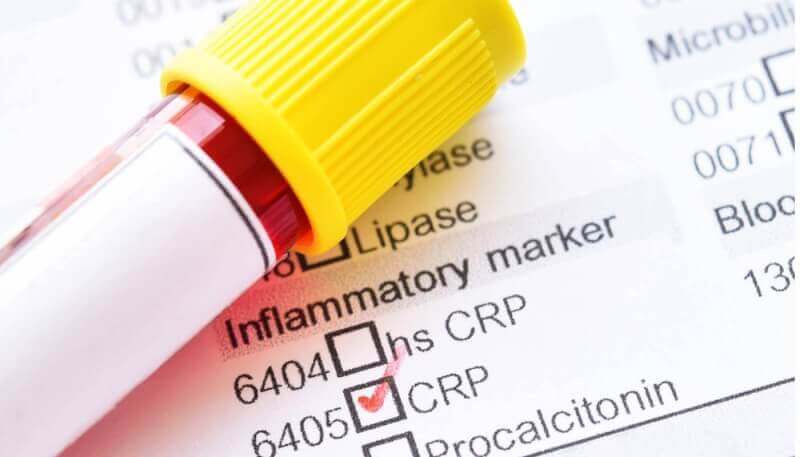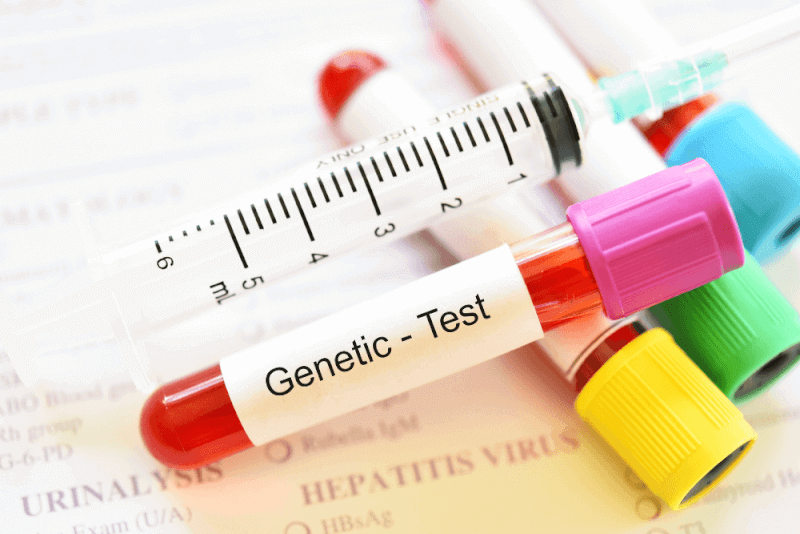30-Second Summary
- CRP levels increase in response to conditions such as infection, inflammation, and tissue damage in the body.
- CRP levels are used in the diagnosis and monitoring of heart and vascular diseases, as well as cancer and many other diseases.
- In a healthy adult, the CRP level is below 1.0 mg/L.
- A CRP level above 3.0 mg/L is considered high.
- CRP levels can be used as an indicator of the severity of infection and the recovery process.
What is CRP (C-reactive protein)?
CRP is one of the proteins produced in the liver. It stands for C-reactive protein and is a response of the body to situations such as tumors, infections, and trauma. The increase in CRP concentration in the body is associated with an increase in white blood cell count and a rise in body temperature. This physiological response by the body occurs to eliminate the factor causing the infection or inflammation. It also plays an active role in repairing the tissue damage caused by the infection.
In a healthy person, CRP concentrations are extremely low. Due to the factors mentioned earlier, CRP concentrations can increase up to 1000 times the normal level within the first 24 hours. Once the factor causing the increase in CRP concentration is eliminated, the values return to normal levels within 18 to 20 hours.
CRP values are particularly used in the diagnosis of cardiovascular diseases, as well as infectious and inflammatory diseases. In addition, CRP tests are used to measure the response of these diseases to treatment.
CRP tests ordered by specialists are used to clarify the diagnosis of diseases such as infection, tumor formation or metastasis, any inflammatory disease, stroke, and heart attack. These tests are also used to determine whether the treatment of these diseases has been successful.
CRP measurement has become an important parameter, especially in the diagnosis of cardiovascular diseases. This test, known as the HS-CRP test, is one of the most definitive indicators of atherosclerosis and helps diagnose inflammation in the heart vessels. HS-CRP tests are also used in individuals who are at higher risk of infection compared to the general population, due to their increased sensitivity.
Causes of High and Low CRP Levels
The CRP value in a healthy adult is 1.0 mg/L. In newborns, this value is low in the first few days but reaches adult levels within a few days. Due to the effects of aging, it is normal for CRP values to rise to 2.0 mg/L. In 90% of healthy individuals, CRP values remain below 3.0 mg/L. Therefore, a CRP value above 3.0 mg/L is considered high, while a value below 1.0 mg/L is considered low. However, these values need to be evaluated on a patient-specific basis.
Many diseases can cause an increase in CRP levels in the body:
- Cancer,
- After surgical operations,
- In cases of organ and tissue damage,
- Trauma,
- Burns,
- Fractures,
- All inflammatory diseases,
- Crohn's disease,
- Mediterranean fever,
- Inflammatory bowel disease,
- Kawasaki disease,
- Systemic lupus erythematosus,
- Rheumatoid arthritis,
- Meningitis,
- Stroke,
- Heart attack,
- Infections,
In addition to these diseases, a slight increase in CRP is considered normal in pregnant women. Postmenopausal women undergoing replacement therapy also show an increase in CRP levels. Additionally, CRP levels are higher in obese individuals and smokers.
A low CRP value indicates that the above-mentioned diseases are not present or, if the patient is undergoing treatment, that the treatment is effective. Generally considered a positive sign, low CRP levels can also be caused by certain medications. A low CRP value is an indicator that a person’s cardiovascular health is good and that their risk of inflammatory diseases is low.
Symptoms of High and Low CRP Levels
High CRP levels do not directly produce symptoms that people can easily recognize. However, an increase in CRP levels due to infection or inflammation may be accompanied by symptoms such as fever, redness, localized warmth, swelling, fatigue, or weakness.
A decrease in CRP levels is not associated with noticeable symptoms. However, if the decrease in CRP is due to the resolution of an infection, the symptoms caused by the infection may diminish.
High CRP Levels During Pregnancy
CRP, a type of protein produced by the liver in response to inflammation in the body, is considered one of the indicators showing that there is more protein in the body than normal.
During pregnancy, significant changes occur in the physiology of women. One of these changes is observed in liver enzymes. Therefore, it is normal for more CRP protein to be produced during pregnancy. However, there is a known healthy range for CRP levels. Levels above this range can be a sign of various problems.
If CRP levels are higher than the established range during pregnancy, there is a risk of fetal growth restriction. This increased risk also brings the possibility of preterm birth and low birth weight. Low CRP levels during pregnancy also pose the following risks:
- Vascular dysfunction
- Insufficient placental development
- Preterm birth
- Neonatal complications
- Preeclampsia and intrauterine growth restriction
CRP in Cancer Patients
CRP levels are considered one of the important indicators in cancer patients. Therefore, it is important to reduce CRP levels. High CRP levels are especially observed in patients with pancreatic cancer, lung cancer, liver cancer, colorectal cancer, urinary tract cancers, esophageal cancer, ovarian cancer, osteosarcoma, and lymphoma. High CRP levels are considered one of the indicators that the disease is progressing negatively. Research has shown that cancer patients with high CRP levels have shorter survival rates compared to those with low CRP levels.
Is high CRP significant in the final stages of cancer?
In the final stages of the disease, 42% of patients experience symptoms such as loss of consciousness, incoherent movements, and disorientation, unfortunately, within the last week before death. In addition to high CRP levels, these symptoms increase with smoking, diabetes, lung cancer, and old age.
At what level does CRP increase to cause cancer?
A significant increase in CRP is considered to be between 5 and 10 mg/L. However, if CRP levels exceed 3 mg/L, the risk of developing certain types of cancer, such as ovarian, lung, colorectal, and uterine cancer, increases.
High CRP Levels in Children
The causes of high CRP levels in children are the same as those observed in adults. CRP levels that increase due to infection are generally seen in children with the following conditions:
- Burns,
- Heart diseases,
- Atherosclerosis,
- Certain types of cancer,
- Pneumonia,
- Inflammation in blood vessels,
- Skin tuberculosis,
- Chronic inflammatory diseases,
- Ulcerative colitis,
- Crohn's disease,
- Inflammation of lymph nodes due to bacteria,
- Joint inflammation,
- Inflammation of the meninges,
- Urinary tract infection,
- Upper respiratory tract infection,
- Lower respiratory tract infection,
Causes of High CRP Levels in Children
High CRP levels in children are usually caused by infections. However, high CRP levels can also be seen in certain metabolic diseases.
- Burn wounds can cause an increase in CRP levels, as they support inflammatory diseases in the body.
- Cardiovascular diseases also cause high CRP levels. They are especially associated with heart disease and atherosclerosis.
- CRP levels also tend to be high in certain types of cancer.
- Pneumonia
- Skin tuberculosis or vasculitis can cause high CRP levels in children.
- Crohn's disease
- Ulcerative colitis
- Joint inflammation
- Inflammation of the meninges,
- Inflammation from urinary tract infections
- Lower respiratory tract infections
- Upper respiratory tract infections
- Inflammatory bowel disease
- Tuberculosis
- Heart attack
- Connective tissue disease
Symptoms of High CRP Levels in Children
Some symptoms of high CRP levels in children are common, while others vary depending on the disease causing the increase in CRP levels. The common symptoms seen in children are as follows:
- Irritability
- Weakness
- Irritability
- Unexpected weight loss
- Difficulty sleeping or insomnia
- Vomiting
- Loss of appetite
- Indigestion
- High fever
High CRP Levels in Infants
One of the values examined in the blood sample taken from the heel of newborns is CRP levels. If high CRP levels are suspected in infants, blood tests are also performed. The most common cause of high CRP levels in infants is infection. If the infection is not treated, significant health problems can occur in the joints, organs, and muscle systems of infants. There are also many factors that can cause high CRP levels in infants.
Causes of High CRP Levels in Infants
In addition to inflammation, other causes of high CRP levels include:
- Pneumonia
- Digestive system disorders such as Crohn's disease or ulcerative colitis
- Thickening of the blood vessels
- Heart diseases
- Inflammation in blood vessels
- Inflammation of the joints
- Bacterial infection of the lymph nodes
- Inflammation in the brainstem
- Upper respiratory tract infection
- Urinary tract infection
- Lower respiratory tract infection
How to Lower CRP Levels in Infants?
To lower CRP levels, it is necessary to identify the cause of the high CRP levels. Treatment is then planned according to this cause. Treating the underlying disease will cause CRP levels to decrease naturally. There is no specific medication to lower CRP levels. However, a healthy diet can help reduce CRP levels more quickly in infants who have started eating solid foods.
Treatment for High CRP Levels
To lower high CRP levels, the underlying cause of the increase must be eliminated first. In cases where high CRP levels are due to lifestyle factors, certain changes need to be made. This is because high CRP levels increase the risk of diabetes and heart disease. It is possible to lower CRP levels by making lifestyle changes. These changes include:
- Reaching an ideal weight,
- Not smoking or avoiding exposure to secondhand smoke,
- Limiting alcohol consumption,
- Avoiding trans fats,
- Not consuming high-calorie foods,
- Choosing plant-based oils like olive oil,
- Opting for low-fat or fat-free dairy products,
- Reducing the consumption of animal products,
- Increasing the consumption of vegetables, fruits, legumes, and whole grains,
- Eating foods rich in fiber,
- Choosing white meat or fish instead of red meat,
- Increasing omega-3 intake,
- Exercising regularly,
- Avoiding processed foods,
- Staying away from foods high in trans fats,
- Reducing the consumption of fried and charcoal-grilled foods.
Nutrition to Lower CRP Levels
A healthy diet is associated with low CRP levels. Therefore, consuming a diet rich in fruits and vegetables and adding foods high in fiber helps keep CRP levels in balance. However, if CRP levels increase due to autoimmune diseases, cancer, injuries, or infections, certain foods can be added to the diet to help lower CRP levels more quickly. Additionally, some foods should be eliminated from the diet, as they increase the body's inflammatory response.
Foods to Include in the Diet to Lower CRP Levels
Some foods help lower CRP levels due to their anti-inflammatory properties. These foods include:
- Turmeric
- Avocado
- Citrus fruits
- Beets
- Olive oil
- Strawberries
- Nuts
- Broccoli
- Leafy green vegetables
- Dark chocolate
- Green tea
- Oily fish
- Dried mulberries
- Garlic
Foods That Increase CRP Levels
While some foods help lower CRP levels, others can cause an increase in these levels. Smoking and excessive alcohol consumption also cause CRP levels to rise. To lower CRP levels, it is important to avoid the following foods:
- Unhealthy fats
- Refined sugar
- Refined foods
- Packaged foods
In cases where high CRP levels are due to an autoimmune disease, it is crucial to identify and eliminate foods that cause inflammation from the diet.
Treatment for Low CRP Levels
Low CRP levels are desirable. Since low CRP levels indicate that the treatment is effective or that the person is healthy, there is no need to intervene to increase them.











